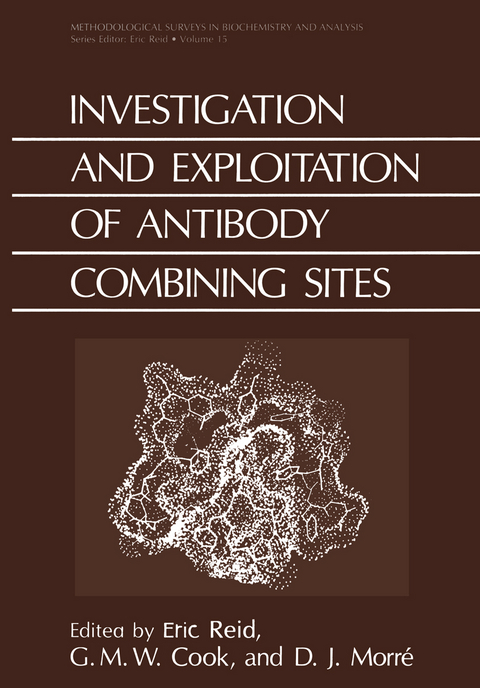
Investigation and Exploitation of Antibody Combining Sites
Springer-Verlag New York Inc.
978-1-4684-5008-8 (ISBN)
#A Antibody Combining Sites, Especially Structure.- #A–1 Antibody combining sites — past, present and future.- #A–2 Variability, modelling and prediction of ?-hairpins with reference to the immunoglobulin fold.- #A–3 Probing the binding sites in crystals of immunoglobulins.- #A–4 Comparative structures of mouse antibody combining sites.- #NC(A) NOTE and COMMENTS related to the foregoing topics*.- #NC(A)–1 An approach to the study of anti-protein antibody combining sites.- #B Production and Characterization of Antibodies, in Contexts such as Receptor Investigation.- #B–1 Investigating the specificity of monoclonal antibodies to protein antigens using ?-galactosidase fusion proteins.- #B–2 Antibody-screening cDNA libraries.- #B–3 Anti-receptor antibodies by the auto-anti-idiotypic route.- #B–4 Production and characterization of anti-morphine anti-idiotypic antibodies.- #B–5 Anti-idiotype antibodies for the study of membrane receptors: the double monoclonal antibody approach.- #NC(B) NOTES and COMMENTS related to the foregoing topics.- #NC(B)–1 Characterization of idiotypes and VH genes of various members of A48-idiotypic network pathway.- #NC(B)–2 Monoclonal internal image anti-idiotypic antibodies of hepatitis B surface antigen.- #NC(B)–3 Structure and expression of genes encoding IgA heavy chains.- #NC(B)–4 Human:mouse antibody-producing transfectoma cell lines.- #NC(B)–5 Different ways to modify monoclonal antibodies.- #NC(B)–6 Restructuring enzymes and antibodies.- #NC(B)–7 Dideoxy mRNA sequencing as a method to analyze antibody diversity.- #NC(B)–8 Effect of multivalent binding on dissociation of monoclonal antibodies from cell surface antigens.- #C Cytoskeletal, Myocyte and Neuronal Studies with Antibodies.- #C–1Immunological approaches and techniques employed in tubulin and microtubule research.- #C–2 Cell-surface events during myogenesis: immunofluorescence analysis using monoclonal antibodies.- #C–3 Differential expression of cell-surface antigens on muscle satellite cells and myoblasts.- #C–4 Cholinergic-specific nerve terminal antigens.- #C–5 Use of antibodies to purify cholinergic nerve terminals.- #NC(C) NOTES and COMMENTS related to the foregoing topics.- #NC(C)–1 An immunological approach to the cell lineage problem in the mammalian CNS.- #NC(C)–2 An enzyme-linked immunosorbent assay for calmodulin.- #NC(C)–3 Intermediate filament diversity as detected by antibodies.- #D Antibody Approaches to Membrane Components Including the T-Cell Receptor.- #D–1 Exploitation of antibodies in the study of cell membranes.- #D–2 Use of polyclonal and monoclonal antibodies in studying complement component C9 as a transmembrane protein.- #D–3 Ca2+-binding proteins located on the cytoplasmic face of the lymphocyte plasma membrane.- #D–4 The T-cell receptor.- #NC(D) NOTES and COMMENTS related to the foregoing topics.- #NC(D)–1 New light on the T-cell receptor in relation to antibody binding sites.- #NC(D)–2 Molecular nature of the T3 antigen of human T lymphocytes.- #NC(D)–3 Organization and expression of the murine T-cell receptor ?-chain gene complex.- #NC(D)–4 Antigen-specific T-cell activation.- #E Antibodies in Relation to Oncology.- #E–1 Requirements by cancer cells for polypeptide growth factors suggest new therapeutic strategies.- #E–2 Monoclonal antibodies to human tumours for targeting cytotoxic drugs.- #E–3 Antigenic modulation as a limiting factor in the treatment of B-cell lymphoma with anti-idiotype antibody.- #E–4 Tumour-associatedcarbohydrate antigens of glycoproteins.- #E–5 Glycolipid antigens: potential in cancer detection and diagnosis.- #NC(E) NOTES and COMMENTS related to the foregoing topics.- #NC(E)–1 Immune surveillance.- #NC(E)–2 WORKSHOP DISCUSSION focused on #E–4, #E–5 & #E–3.- Guidance for ‘uninitiated’ readers.- Corrections to Vol. 13.
| Reihe/Serie | Methodological Surveys in Biochemistry and Analysis ; 15B |
|---|---|
| Zusatzinfo | 175 Illustrations, black and white; 359 p. 175 illus. |
| Verlagsort | New York, NY |
| Sprache | englisch |
| Maße | 170 x 244 mm |
| Themenwelt | Naturwissenschaften ► Chemie |
| ISBN-10 | 1-4684-5008-5 / 1468450085 |
| ISBN-13 | 978-1-4684-5008-8 / 9781468450088 |
| Zustand | Neuware |
| Haben Sie eine Frage zum Produkt? |
aus dem Bereich


